 Katie Morley
Katie Morley
Apr 12, 2023
 Katie Morley
Katie Morley
Apr 12, 2023
Customer journey orchestration in the beauty industry is a skill that has become increasingly complicated; consumers are savvier and have higher expectations than ever before.
In the past, customers found and tried new items in brick-and-mortar stores, but now they discover and evaluate products online. They follow Instagram beauty influencers, watch TikTok and Youtube review videos, and look for video testimonials in Facebook groups.
They expect brands to offer product finders, online trial apps, and virtual makeup rooms on the website. They also expect personalized push notifications and suggestions in line with their buying habits.
With so many options out there, customers have zero tolerance for bad shopping experiences. This means brands have to dig deeper into their consumer data to clearly understand their customer: behaviors, what consumers actually want, and what makes them excited to buy.
Brands then need to leverage those insights to orchestrate personalized customer journeys and develop strategies to acquire customers at every touchpoint of these journeys.
To help you get started, we’ve created this comprehensive guide on customer journey orchestration in the beauty industry. We want to get right into it, but before we do, you first need to know about omnichannel customer journeys. This will help to understand how modern shopping experiences have changed and help you build out your customer journey map.
Complex omnichannel customer journeys
Consumer behaviors in the beauty industry
Personalized customer journey orchestration in the beauty industry
What are behavioral segments?
Product discovery funnel in beauty
Offer strong incentives to convert first-time customers
Loyalty program funnel in the beauty industry
Improve post-purchase experience to build long-lasting relationships
Tweak the registration page and get more registrations
Lead collection funnel in the beauty industry
Mobile App download funnel in the beauty industry
Referral funnel in the beauty industry
Ready to revamp your customer journey?
Customer Journey Orchestration FAQs
‘Customer journey’ refers to the path that takes a shopper from:
Not knowing a product > Purchasing > Becoming a loyal customer
It lays out all touchpoints that your customer may have with your brand before, during, and after the experience of that product. Your growth starts with understanding customer journey marketing with your brand.
Insider research into traditional customer journeys shows that all customers follow a similar, simple path:
However, the modern customer journey is more complex, with numerous touchpoints and channels. It consists of highly connected, non-linear moments.
According to Nielsen Brandbank, 66% of global shoppers have changed how they buy into categories and brands.
IBM even emphasized that today’s consumers “shop whenever and wherever the mood strikes them, in so-called ‘micro-moments,’ often while doing other tasks.”
Lisa is a customer. Her best friend recommended an online cosmetic store, so she decided to check it out.
As she clicked through to the website, her first “recordable” entry into the customer journey began. While browsing lipstick products, she became distracted, abandoned her cart, and left. An hour later, she got a Web Push.
Later, an email arrived and reminded her that she had left something in their cart. But she was on her way home, so she ignored the email. That evening, a targeted Facebook ad gave her the final prompt she needed. She read the comments, felt excited, and decided to buy.
Lisa loved the lipstick so much that she began buying exclusively from this store. She even shared her positive experience with her friends and colleagues.
As you can see, consumers don’t always buy on the first visit to a website. They now rely on brand awareness, research, and recommendations across multiple channels, before making a purchase.
They also don’t necessarily engage with all the journey touchpoints offered to them before finalizing their decision to buy.
To keep up with changes in customer behaviors and maximize ongoing sales, brands should move from traditional customer journey marketing to the customer loyalty loop.
In the book, The Customer Loyalty Loop: The Science Behind Creating Great Experiences and Lasting Impressions, author Noah Fleming defined the customer loyalty loop as “an updated view of the traditional customer lifecycle model, applied to the entire customer experience and the individual customers within it.”
Here’s a good model of what the customer loyalty loop looks like:
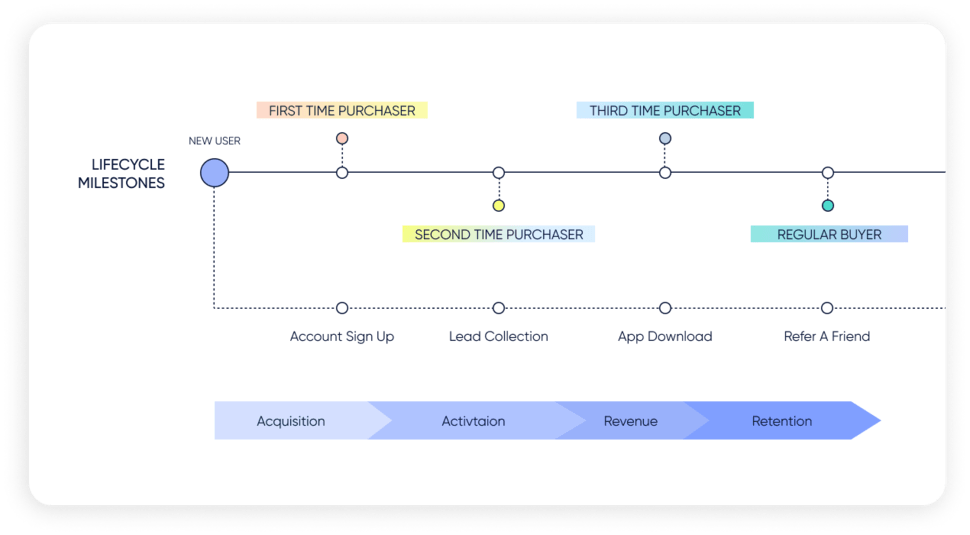
In this model, lifecycle milestones outline every customer’s lifetime journey with your brand on their way to becoming a loyal and high-value customer. These milestones determine your customer lifecycle stage segments.
When you’ve orchestrated a customer journey, you can see the big picture: where a given customer is at any stage—what they want, what they’re interested in, what they hope to get from you, and how likely they are to buy from you.
Then, you can set up the right messages for each channel based on a customer’s lifecycle status.
The following graphic reveals a complete picture of beauty consumers’ shopping journey:
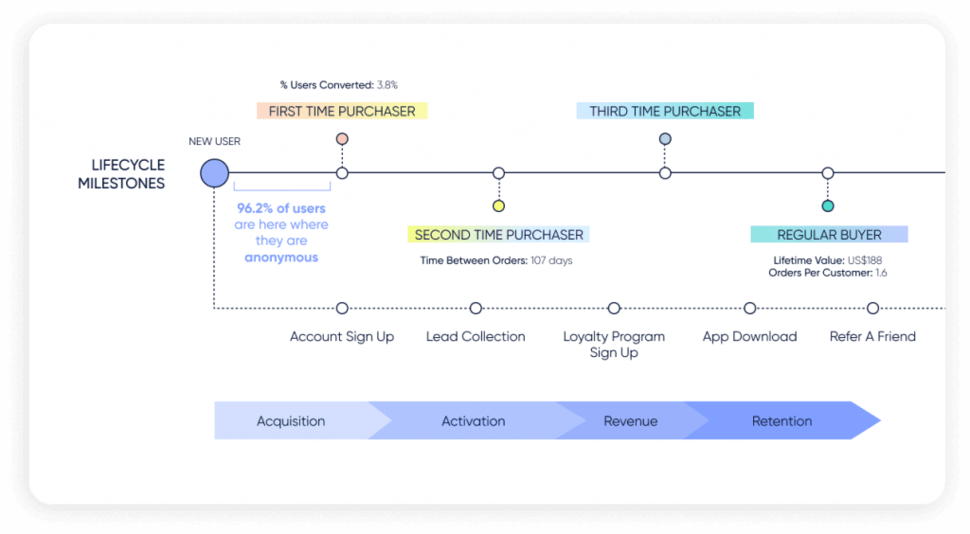
There are some vital points to remember:
Firstly, more and more beauty consumers are moving to online shopping. PowerReviews’ research shows that over 53% of shoppers buy more beauty products online now, compared to pre-Covid-19 times. The number is even higher among younger consumers.
About 66% of Gen Z shoppers and 58% of millennials also said they spend more online on beauty products now than they did before the pandemic. Secondly, social channels and influencers play an important role in product research and evaluation, especially among people aged 18-34 years.
In a study conducted by Facebook IQ, most surveyed shoppers said they rely heavily on social media platforms to discover makeup and facial skincare products. Approximately 44% of beauty shoppers said they were likely to purchase based on a social media post.
Thirdly, beauty consumers now seek personalization at every stage of their purchase journey, and they expect unified buying experiences across online and physical platforms.
According to Mintel, beauty personalization should allow consumers to express their unique character while offering clear benefits. It should also be used to reach those who seek product inspiration and assistance.
A personalized customer journey is tailored to the needs of specific customers. It’s intended to help customers get exactly what they want.
A thoughtful, personalized customer journey captures not only a one-time purchase but also builds the foundation for future purchases.
To create a personalized customer journey, you need to put yourself in your customers’ shoes and think critically about how they decide what to buy. Then, divide your target customers into different segments based on their behaviors.
One way to make this process easier is by evaluating the lifecycle milestones of the customer loyalty loop. At each lifecycle milestone, brands should optimize important immediate conversion funnels.
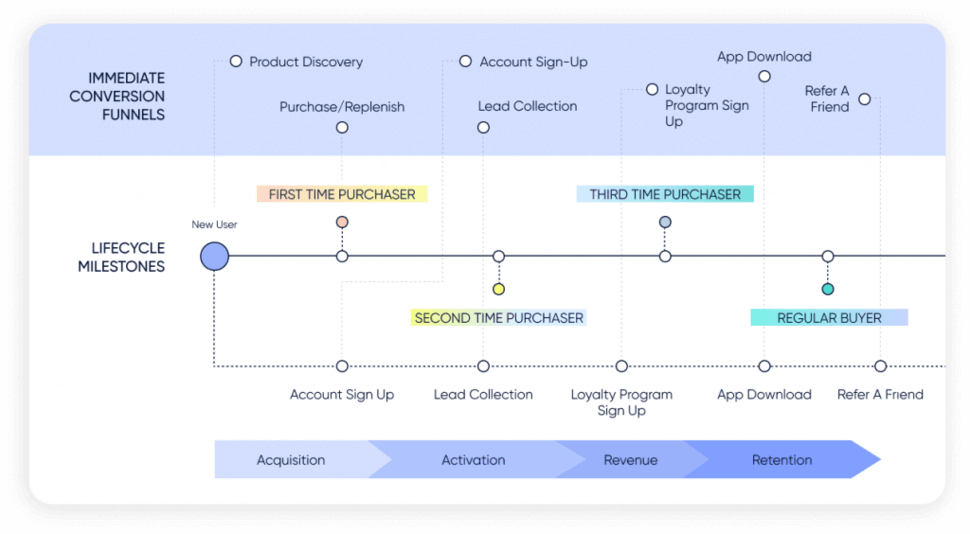
Conversion funnels are the specific destinations you’re trying to drive your customers towards. They might be product discovery, account sign-ups, newsletter subscriptions, or the purchase itself. These conversion funnels determine behavioral segments.
A behavioral segment is a group of customers clustered together by one behavioral trait, for example, purchase history. You can create behavioral segments by using behavioral market segmentation.
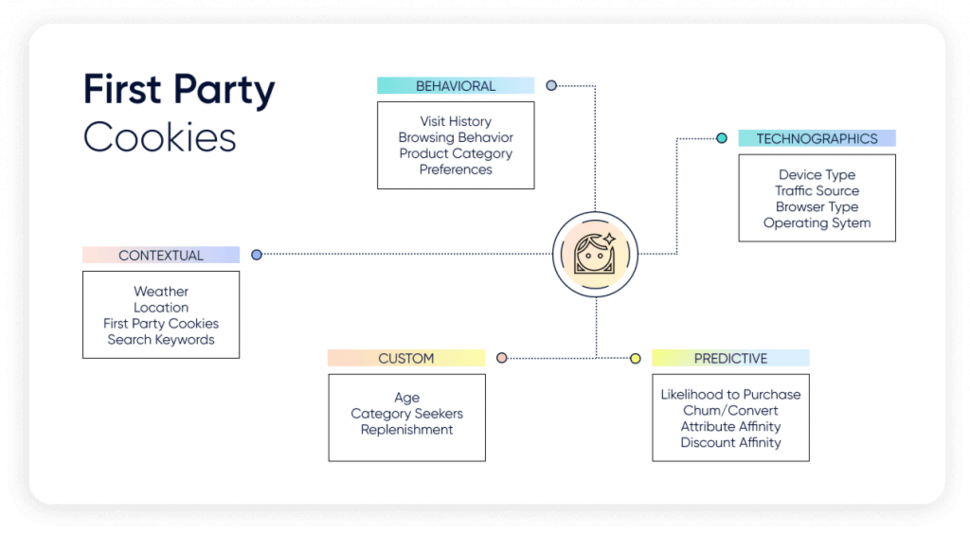
Behavioral segmentation refers to the practice of identifying and grouping customers based primarily on their online browsing and decision-making patterns. It’s dynamic, ad-hoc, and adaptive as it depends on constantly changing variables.
Below are four common examples of behavioral segmentation:
Once you define behavioral segments, you can combine them with the customer journey to develop a plan to convert those segments into loyal customers.
A product discovery funnel aims to provide customers with clear information about products, establish trust, and speed up the path to purchase.
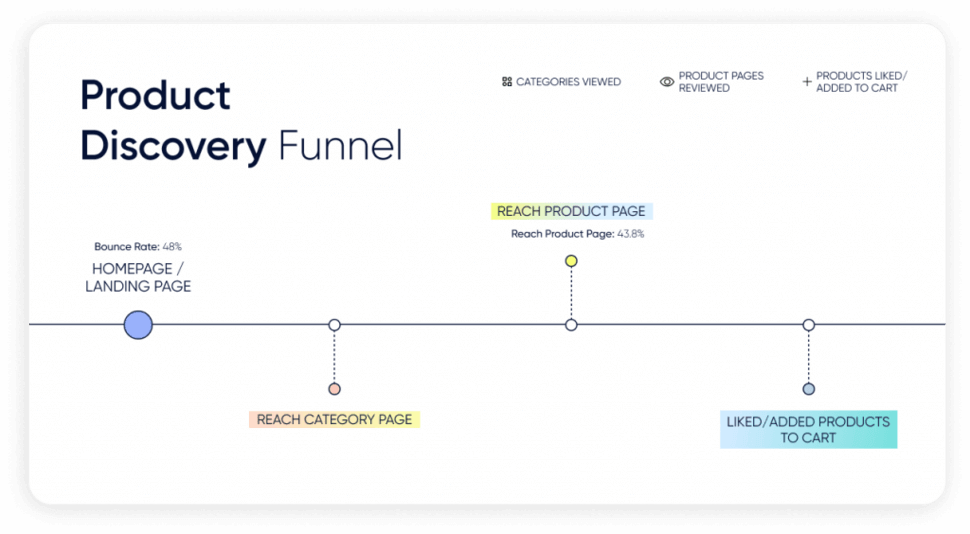
When creating this funnel, you should minimize the number of clicks and searches shoppers need to take to find the right products.
Also, keep customers’ personal demographics and preferences in mind—skin type, tone, preferred ingredients—to avoid alerting them to products they’re not interested in.
You can use the following strategy to increase product awareness:
Tap on behaviors that customers are familiar with from social media channels to drive fun and effective product discovery with InStory, an immersive Instagram-like experience for Mobile Web.
Using InStory, you can quickly and easily share campaigns, products, and collections in story form, based on each user’s needs and interests, to maximize the value of every precious pixel.
Segment: All customers.
Strategy: Showcase bestsellers, celebrity product lines, sale items, last-minute
deals, customer stories, news updates, influencer diaries, or other noteworthy
products from the collection with clickable InStory placements at the top of the
homepage.
You can also create personalized stories based on customers’ preferences to offer relevant recommendations as soon as they land on your mobile website homepage.
KPIs to track: Click-through rate (CTR)

On average, it takes 5 clicks, 3 searches, and 5 filters for customers to find what they’re looking for on the mobile web. But not everyone has the time—or patience—to go through that many steps.
Since your users have already gone down the funnel searching for a single product, it makes sense to give them easy ways to discover other products.
One way to do that is to take advantage of Insider’s Smart Recommender, which is powered by artificial intelligence (AI) and data collected from users across platforms.
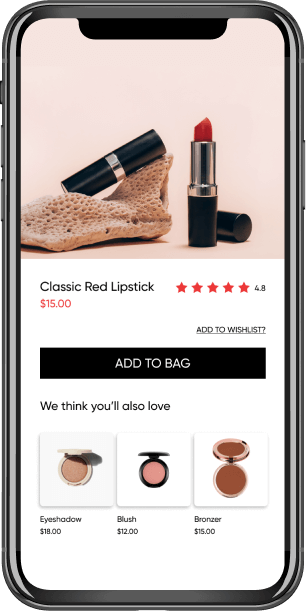
Segment: All customers
Strategy: On product pages, show personalized product recommendations below
the main section with product information.
Think about “frequently bought together,” “you might also like,” “similar products,”
“similar categories,” and “previously viewed.”
When you do that, you remove choice overload for customers and give them
products that fit their interests and demographics.
KPIs to track: Add-to-cart rate, average order value (AOV)
Currently, products related to health and beauty have an eCommerce conversion rate of 3.08%. If your conversion rate is below this benchmark, you should review your purchase/replenishment funnel and optimize it. The key is to analyze conversion rates from one stage of the funnel to the next and figure out what drives customers to take action.
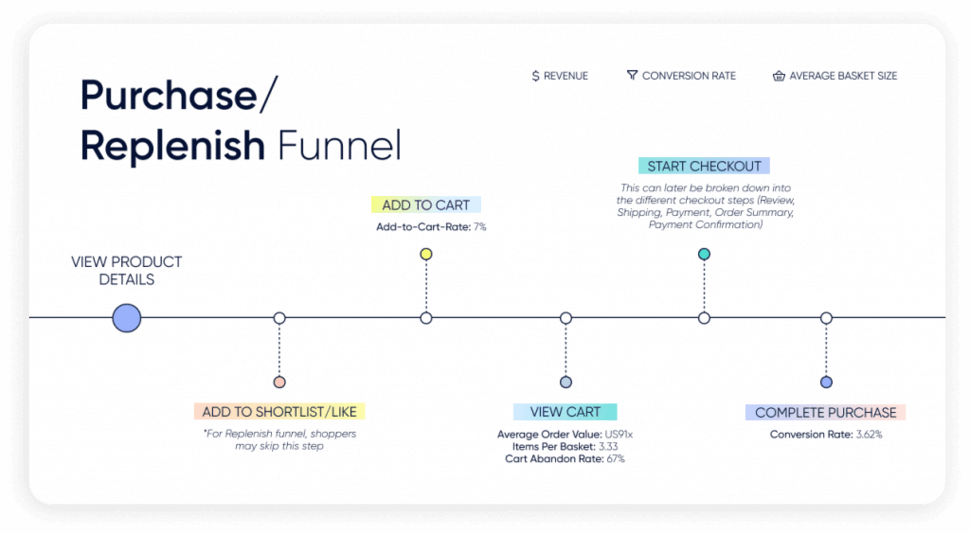
It’s worth noting that beauty consumers are ultra-cautious and don’t want to risk buying the wrong thing.
According to Nosto’s 2020 survey of 2,000 US and UK Gen Z and millennial consumers, 56% agreed that, when shopping online, they tend to stick with brands or products they’ve bought before rather than trying anything new. The figure increased to 62% for female shoppers alone.
When revamping your purchase/replenishment funnel, you should develop specific strategies for first-time purchasers and repeat customers.
You can use the following strategy to help convert first-time buyers:
To acquire new customers, a good tactic is to give them a compelling incentive for their first purchase and make this offer prominent across your website.
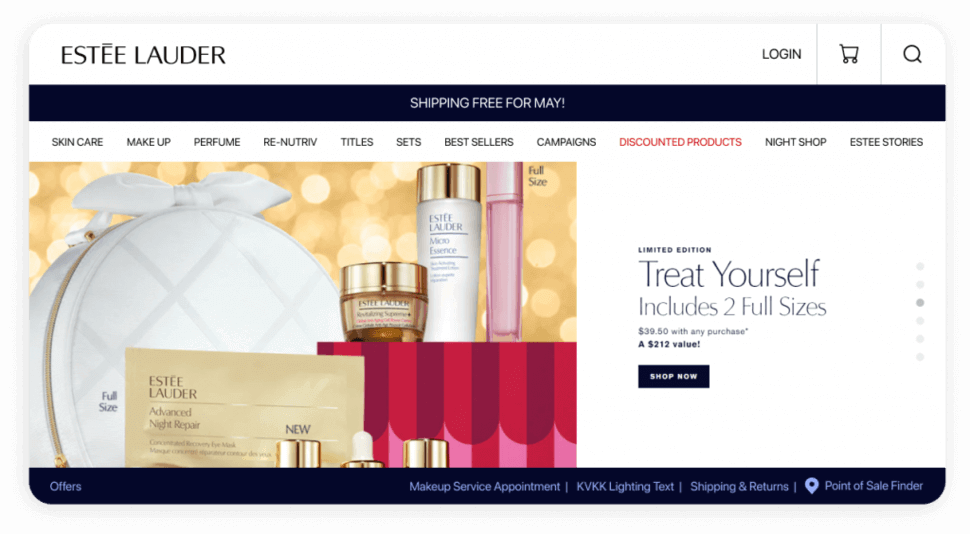
Segment: Customers who haven’t made a purchase at all.
Strategy: Show a sticky hello bar at the top of the page highlighting an exclusive first-order offer. For example, offer free shipping with no minimum spend or a discount percentage with no code needed.
Note that you don’t need to offer deep discounts to entice shoppers to buy.
According to First Insight’s survey, 38% of women would make a beauty purchase for a discount of 30% or less, compared to 29% of women who would purchase for a 30-50% discount, and 14% who would look for a discount of 50% or more.
KPIs to track: Add-to-cart rate, conversion rate
Another incentive to help overcome the challenge of acquiring new customers is with a loyalty program. Using a loyalty program is critical for increasing the customer retention rate and driving sales. By creating a loyalty program your customers are more likely to return, which increases their lifetime value and strengthens your brand community.
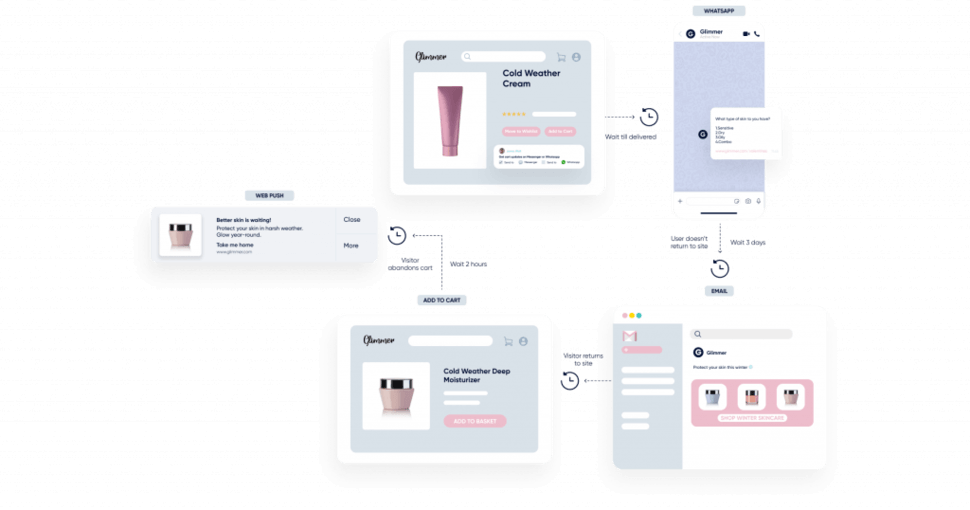
You can use the following strategy to drive more loyalty program sign-ups:
For customers who have shown interest in your loyalty program but haven’t yet signed up, highlight the benefits of participation to bring them into the funnel.
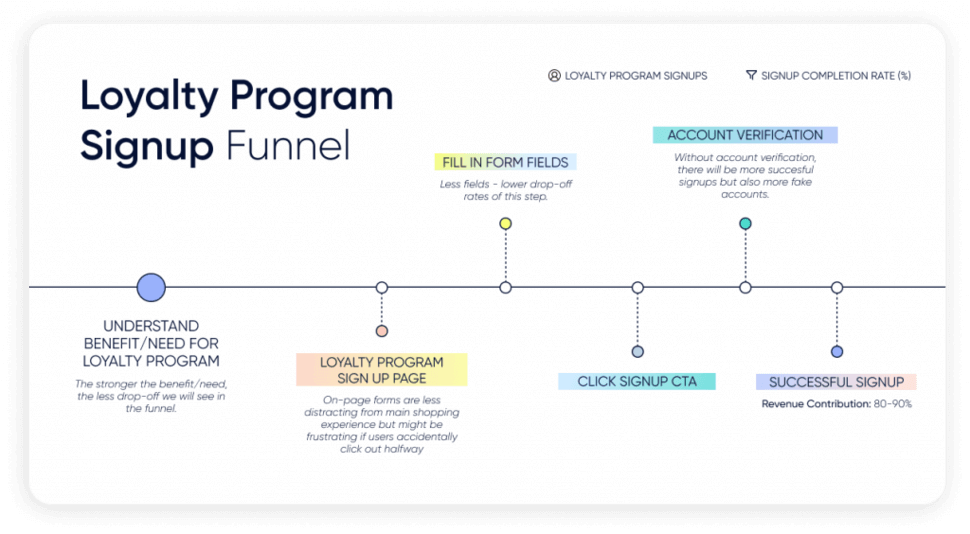
You can use the following strategy to drive more loyalty program sign-ups:
For customers who have shown interest in your loyalty program but haven’t yet signed up, highlight the benefits of participation to bring them into the funnel.
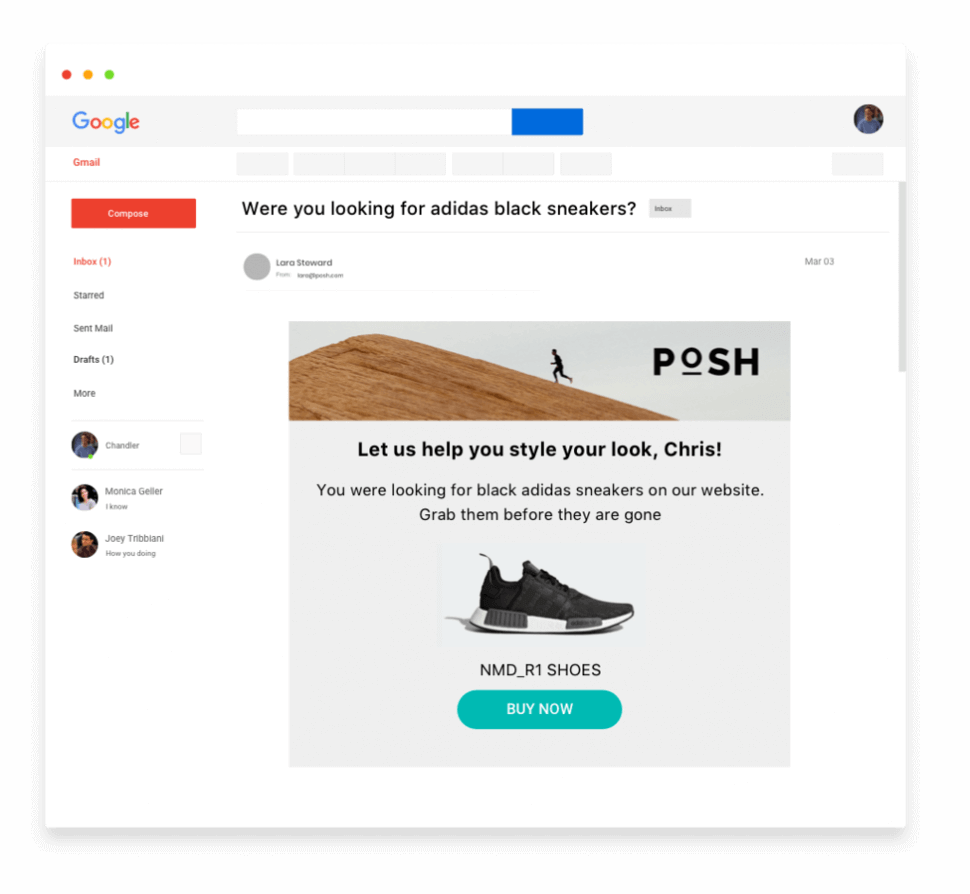
Segment: Shoppers who visited your loyalty program registration page but didn’t complete the form.
Strategy: Send a registration abandonment email one day after featuring the benefits of the loyalty program.
KPIs to track: Email click-through rate, loyalty program registration rate.
Once shoppers have made a purchase, you should have a plan to continue engaging with them in order to turn them into loyal customers.
The best practice is to build an exceptional post-purchase experience with multichannel journey orchestration. This ensures that all the messaging is interconnected, and there’s no possibility of a communication lapse.

Segment: First-time purchasers.
Strategy: Run a personalized customer journey filled with attractive offers after a shopper makes their first order.
You can also set up local events with exclusive invites, remind customers to restock a product they previously bought, or upsell complementary products that work well with what they already purchased.
KPIs to track: Conversion rate
Because creating a new user account is one of the primary reasons for high abandoned cart rates, guest checkout becomes critical in an eCommerce store. This leads to a lot of challenges in driving account sign-ups.
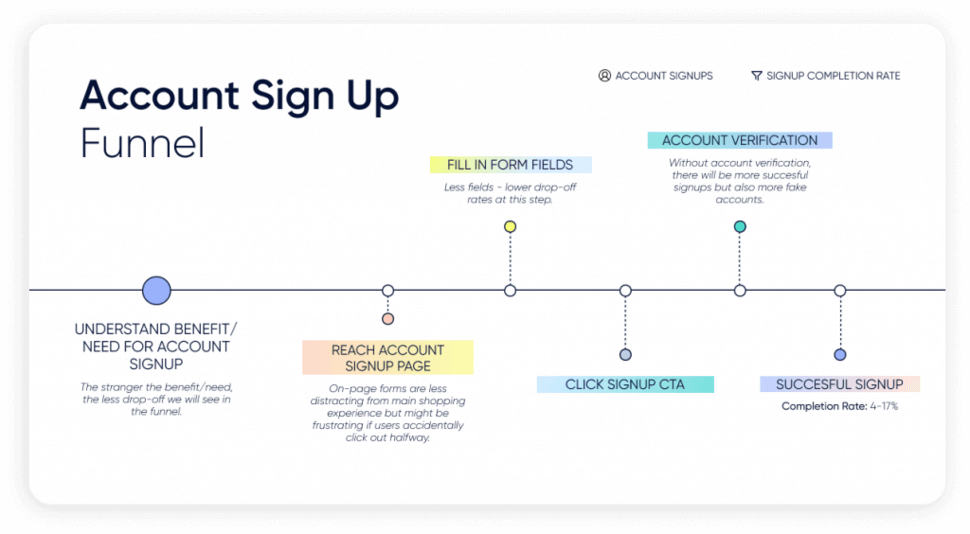
Insider’s AI-powered journey builder Architect, allows brands to engage first-time shoppers with the right content at every touchpoint they move through, encouraging them to sign up for an account.
Architect identifies the channel these shoppers are most active on, automating the engagement to target each shopper on their preferred channel at the right time.
Whether you want to increase sign-ups or reengage previous customers, personalizing marketing touch points with a solution like Architect increases the likelihood of conversions.
⭐️⭐️⭐️⭐️⭐️
“We achieved 4X ROI with Insider’s cross-channel marketing campaigns. Insider has helped us segment our customers better and reach them at the right time on the right channel, and this has led to a 20% uplift in conversions.
— Digital Marketing Assistant, Global Brand, G2 Reviews
If increasing registrations is your goal, here’s another strategy you can use:
Not all shoppers are interested in signing up for a new account when visiting an eCommerce store. And not all of them understand the benefits of doing that.
To maximize sign-ups, you should clarify what benefits shoppers will receive after signing up and make the form eye-catching to draw their attention.
Also, test multiple layouts to determine which one brings the highest conversion rate, and then capitalize on it.
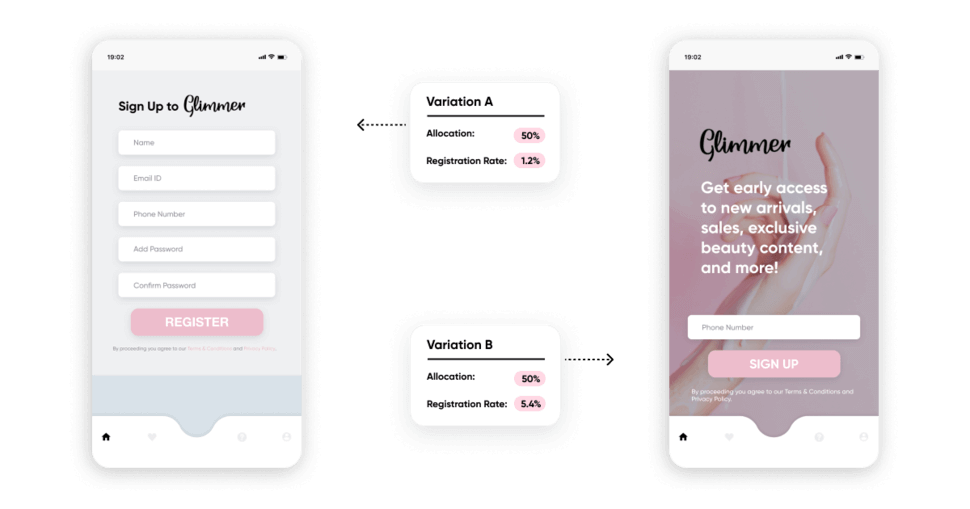
Segment: First-time visitors.
Strategy: Tweak key elements like images, titles, and buttons on a live app with no code changes, or store deployments in the mobile app. Then, split the segments 50/50 and run an A/B test.
KPIs to track: Registration rate.
A lead is anyone who has shown interest in your brand or products. They might have explored a few of your products by clicking on a Facebook ad or landing on our website, but they’re yet to make an order.
When you collect leads, you can send customers retargeting emails with content, recommendations, and promotions tailored to their needs.
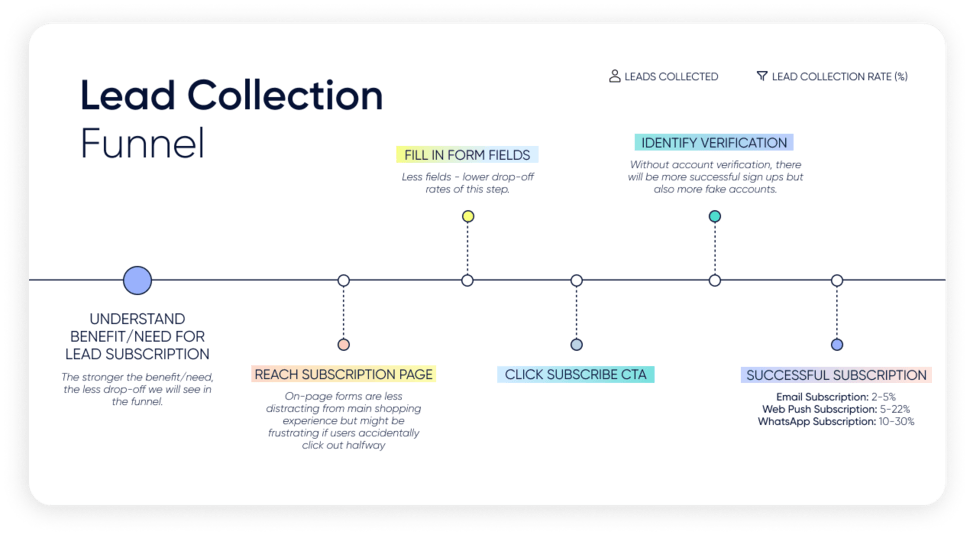
Traditional opt-in popup overlays can be useful, but most people perceive them as irritating and immediately look for the exit button.
Nielsen Norman Group even found that popups are the “most hated advertisement technique on desktop.”But that doesn’t have to be the case. You could replace the traditional opt-in form with a fun, interactive “spin-to-win” popup.
It’s excellent for enhancing the shopping experience while providing you with valuable insights into your customers’ behaviors.
Insider offers four gamification techniques to capture leads and help hit KPIs: Web Push, Scratch to Win, Wheel of Fortune, and Progress Bar.

Segment: Shoppers who haven’t signed up for your newsletter.
Strategy: Show a spin-the-wheel notification with incentives for their first purchase, for example, 10% off. You can also ask them to leave their contact details before unlocking the offer.
KPIs to track: Spin click-through rate (CTR), average session duration, conversion rate, and lead subscription rate.
⭐️⭐️⭐️⭐️⭐️
“In only 4 months we have seen an 8.6x ROI and a 9.6% CR uplift with Insider. We have used gamification templates such as ‘Wheel of Fortune’ or ‘Swipe’ to significantly improve our lead generation strategies and increase user engagement. This is a hugely scalable, always evolving, cross-channel platform that is easy to use and very effective.
- Jesús R., Product Owner, G2 Reviews
Many beauty brands have applied new technologies like augmented reality (AR) and virtual reality (VR) to design their mobile apps. These apps are great for boosting customer engagement, adding value to your brand, and driving more conversions.
To make sure your Mobile App helps you achieve your goals, you should develop a funnel specifically for Mobile App download, as shown below:
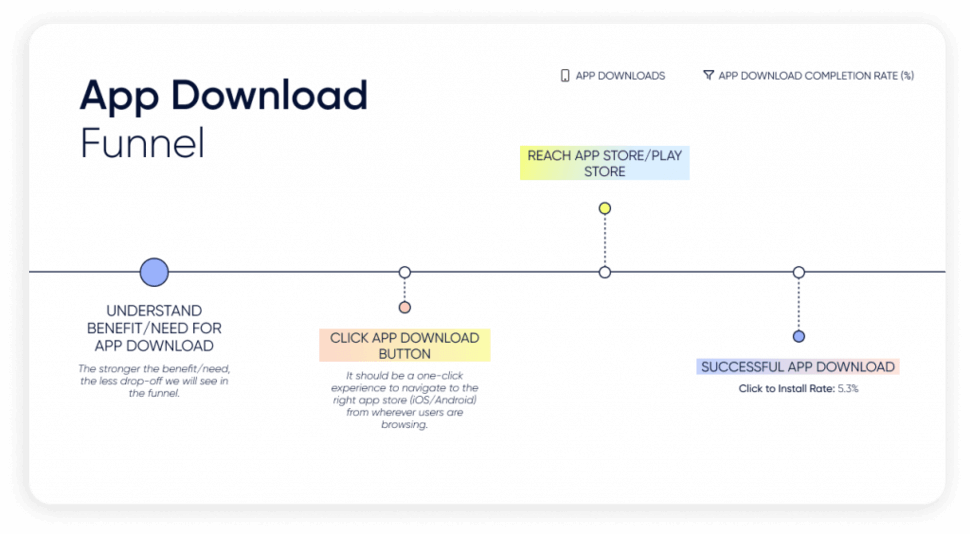
In this funnel, the Click to Install rate refers to the percentage of users who successfully install apps after clicking on a link to download an app.
Your Click to Install rate will vary significantly across the different channels designed to drive users to download the app, for example, via a post-purchase app download banner or a smart banner.
Follow this tip to drive more loyalty program sign-ups:
Smart banners at the top of your Mobile Web experience can help convert your mobile Web traffic into Mobile App downloads.

Segment: All users
Strategy: Launch a smart banner on the success page. When creating the banner, you should run A/B tests to determine what type of prompt brings the highest Click to Install rate.
KPIs to track: Banner click-through rate, new mobile users.
According to PowerReviews, approximately 74% of Gen Z shoppers and 66% of millennials say they are swayed to purchase beauty products by influencers they follow.
Happy and loyal customers are the driving force for your growth. Acquiring new customers is one thing, but you should ultimately aim to transform loyal customers into brand ambassadors who trust and recommend your products.
On average, a referral program can help drive up to 30% increases in new customer acquisition and can increase first-order value by 10-25%.
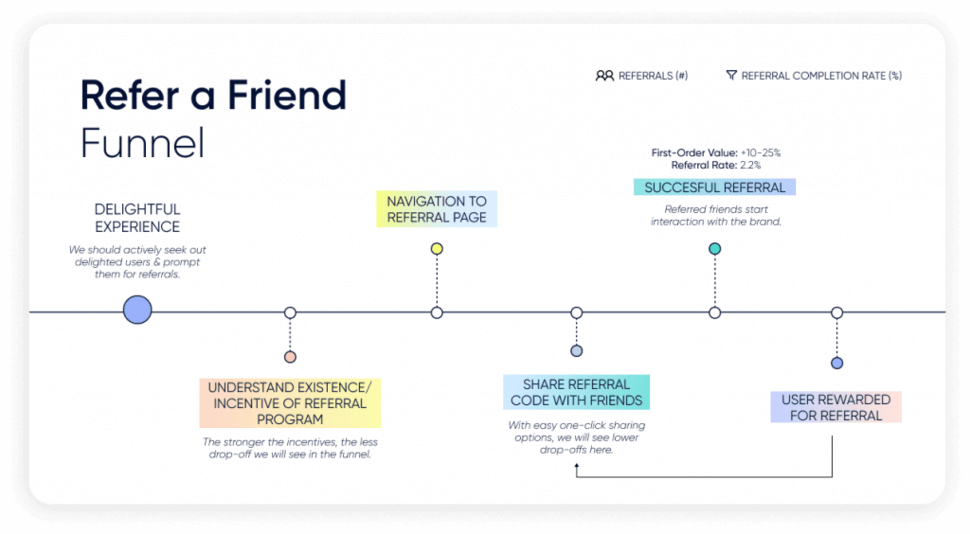
You can use the following strategy to encourage referrals:
Research what motivates your customers to give you a referral, and then design your referral programs to provide rewards addressing their motivation. Once you’ve come up with the motivation and your campaign is ready to launch, it’s important to keep timing in mind.
Consumers are far more likely to recommend your brand when they’re feeling excited rather than when they’re in the middle of doing something else. A good practice is to recommend a referral a few days after they’ve received their order.
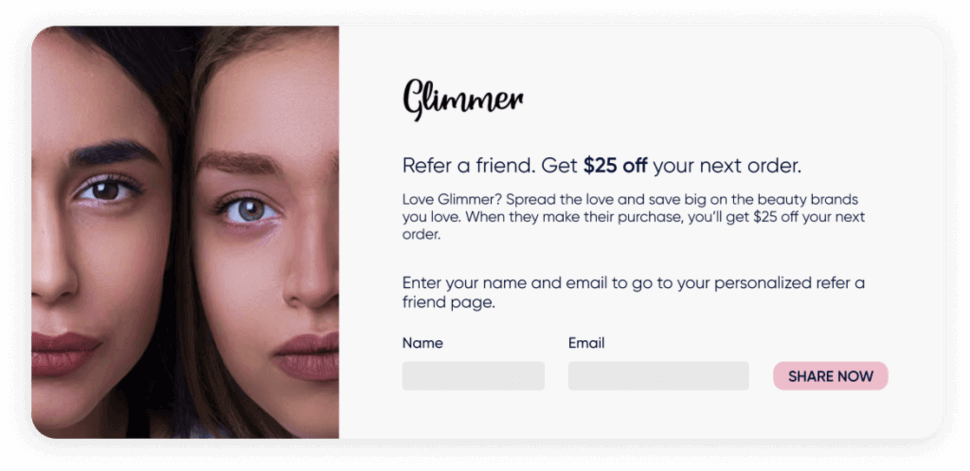
Segment: All users
Strategy: Offer incentives to your customers and those to whom they refer your products. Incentives offered might be a discount percentage, a free sample of your new product, or loyalty points.
Then, promote your referral programs across various channels, from your website to emails to social media accounts.
KPIs to track: Referral rate, conversion rate
The expectations and behaviors of beauty consumers have fundamentally changed. To maximize customer loyalty and sales, brands should dive into their customer data to understand what customers need and expect.
You’ll then be able to leverage those insights and technology to connect with customers and deliver seamless, personalized shopping experiences.
Interested in enhancing your customer journey? Get in touch.
For more in-depth beauty resources, check out our guide: Beauty & Cosmetics in 2022: A guide to stellar sales and loyalty.
Customer journey orchestration refers to the process of designing and delivering a seamless, personalized experience for customers across all touchpoints and interactions with a brand.
It involves leveraging data and technology to understand and anticipate customers’ needs and preferences. You can then deliver relevant and timely messages, content, and experiences to result in conversions and acquisition.
The customer journey is important because it analyzes how your prospective and current customers interact with your brand at each touch point.
By mapping out the customer journey, companies will gain insights into customer behavior and help identify any pain points or opportunities for improvement.
To orchestrate a customer journey, you need to map out and identify how and where your customers come from.
Based on your understanding of your customer journey and personas, you can then develop a strategy and use a platform like Insider to deliver personalized and engaging experiences to customers at each touchpoint
Find inspiration for your company’s customer journey orchestration using the strategies within this article.

Written by
Katie Morley
Katie is an award-winning content marketer with over eight years of experience in content strategy, development, and copywriting. As Global Content Director at Insider, she currently oversees content strategy across 26 regions. Fun fact: Katie read 64 books last year (for which she owes a long commute and two week-long holidays where she spent approximately six hours a day with her nose in a book).